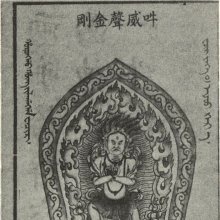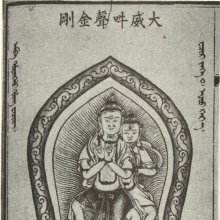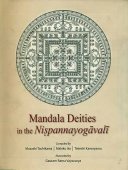Vajrahumkara, Vajrahūṃkāra, Vajrahūṅkāra, Vajrahunkara, Vajra-humkara, Vajra-hunkara: 5 definitions
Introduction:
Vajrahumkara means something in Buddhism, Pali. If you want to know the exact meaning, history, etymology or English translation of this term then check out the descriptions on this page. Add your comment or reference to a book if you want to contribute to this summary article.
Images (photo gallery)
In Buddhism
Tibetan Buddhism (Vajrayana or tantric Buddhism)
Source: archive.org: The Indian Buddhist IconographyVajrahūṃkāra (वज्रहूंकार) refers to one of the various emanations of Akṣobhya having their Sādhana described in the 5th-century Sādhanamālā (a collection of sādhana texts that contain detailed instructions for rituals).—Only one sādhana in the Sādhanamālā describes the form of the god Vajrahūṃkāra, who is so-called because his two hands carrying the vajra and the ghaṇṭā exhibit the vajrahūṃkāra-mudrā.
Vajrahūṃkāra (two-armed variety).—[His Colour is blue; his Āsana is the pratyālīḍha; his Symbols are the tarjanīpāśa and vajra]—The Dhyāna (meditation instructions) in the Sādhanamālā is as follows:—
“The worshipper should conceive himself as the god Vajrahūṃkāra, who originates from that syllable (Hūṃ) and is terribly fierce inappearance. He laughs horribly, is wrathful, and disturbs the three worlds. His two hands carrying the ghaṇṭā and the vajra are locked in the vajrahūṃkāra-mudrā. He tramples upon Bhairava, in the pratyālīḍha attitude, and inspires awe”.
Vajrahūṃkāra (six-armed variety with three faces and six arms).—He is described in the Niṣpannayogāvalī is as follows:—
Source: De Gruyter: A Fragment of the Vajrāmṛtamahātantra[Vajrahūṃkāra is the principal deity in the Vajrahūṃkāra-maṇḍala of the Niṣpannayogāvalī, and is identified with Trailokyavijaya, He is three-faced and six-armed. With his two principal hands arranged in the trailokyavijaya-mudrā and holding the vajra and ghaṇṭā he embraces the Prajñā of his own creation. With the two remaining right hands he holds the goad and the noose, and with the two left he shows the skull-cup and the khaṭvāṅga].
Vajrahūṃkāra (वज्रहूंकार) is the name of a deity as defined in the ‘vajrahūṃkāra-sādhana’ chapter of the 9th-century Vajrāmṛtatantra or Vajrāmṛtamahātantra: one of the main and earliest Buddhist Yoginītantras. The Bhagavān explains in brief the sādhana of Vajrahūṃkāra, as well as the procedures for drawing the maṇḍalas of Vajrāmṛta, Heruka, and so on. The shape and the measures of the vajrahūṃkāra-maṇḍala are given in stanza 2. Vajrahūṃkāra, who has three faces and six arms, has to be placed in the centre of this maṇḍala, surrounded by a halo of trembling lights, embellished with ornaments, and encircled by four mudrās (Kelikilā, Vajrāstrā, Vajragarvā, Sparśavajrā). [...] After having performed the oblation in the middle (of the maṇḍala), if the practitioner desires the supreme perfection, i.e. if he wishes to realize Vajrahūṃkāra, he should recite the mantra of one single syllable (i.e. the sound hūṃ).
Source: academia.edu: A Critical Study of the Vajraḍākamahātantrarāja (II)Vajrahūṃkāra (वज्रहूंकार) is the husband of Surābhakṣī: the name of a Ḍākinī (‘sacred girl’) presiding over Kosala: one of the four Upakṣetra (‘sacred spot’) present within the Vākcakra (‘circle of word’), according to the 9th-centruy Vajraḍākatantra. The Vākcakra is one of three Cakras within the Tricakra system which embodies twenty-four sacred spots or districts resided over by twenty-four Ḍākinīs whose husbands (viz., Vajrahūṃkāra) abide in one’s body in the form of twenty-four ingredients (dhātu) of one’s body.
Surābhakṣī has for her husband the hero (vīra) named Vajrahūṃkāra. She is the presiding deity of Kosala and the associated internal location are the ‘tip o the nose’ and the bodily ingredients (dhātu) are the ‘wreath of entrails’.
Source: academia.edu: The Structure and Meanings of the Heruka MaṇḍalaVajrahūṃkāra (वज्रहूंकार) is the name of a Vīra (hero) who, together with the Ḍākinī named Surābhakṣī forms one of the 36 pairs situated in the Vajracakra, according to the 10th century Ḍākārṇava chapter 15. Accordingly, the vajracakra refers to one of the four divisions of the sahaja-puṭa (‘innate layer’), situated within the padma (lotus) in the middle of the Herukamaṇḍala. The 36 pairs of Ḍākinīs and Vīras [viz., Vajrahūṃkāra] each have one face and four arms; they hold a skull bowl, a skull staff, a small drum and a knife; they are dark-bluish-black in color.
Source: OSU Press: Cakrasamvara SamadhiVajrahūṃkāra (वज्रहूंकार) is the name of a Ḍāka (male consort) and one of the deities of the Cakrasaṃvara-maṇḍala or Saṃvaramaṇḍala of Abhayākaragupta’s Niṣpannayogāvalī, p. 45 and n. 145; (Cf. Cakrasaṃvaratantra, Gray, David B., 2007).—The Cakrasaṃvara mandala has a total of sixty-two deities. [...] Three concentric circles going outward, the body, speech and mind wheels (kāya-vāka-citta), in the order: mind (blue), speech (red), and body (white), with eight Ḍākinīs each in non-dual union with their Ḍākas, "male consorts".
Associated elements of Surābhakṣī and Vajrahūṃkāra:
Circle: vākacakra [=vākcakra?] (speech-wheel) (red);
Ḍākinī (female consort): Surābhakṣī;
Ḍāka (male consort): Vajrahūṃkāra;
Bīja: koṃ;
Body-part: nose tip;
Pīṭha: Kosala;
Bodily constituent: antra (large intestine);
Bodhipakṣa (wings of enlightenment): smṛtibala (power of mindfulness).

Tibetan Buddhism includes schools such as Nyingma, Kadampa, Kagyu and Gelug. Their primary canon of literature is divided in two broad categories: The Kangyur, which consists of Buddha’s words, and the Tengyur, which includes commentaries from various sources. Esotericism and tantra techniques (vajrayāna) are collected indepently.
See also (Relevant definitions)
Partial matches: Humkara, Vajra.
Starts with: Vajrahumkaramandala, Vajrahumkarasadhana, Vajrahumkarasadhananirdesha.
Full-text (+15): Surabhakshi, Vajrahumkarasadhana, Antra, Smritibala, Vajrahumkaramandala, Vajrasattvamandala, Kom, Analarka, Vajrapatala, Vajrakundali, Herukavajra, Vajrayaksha, Vajrakala, Vajradanda, Trailokyavijaya, Padmantaka, Takkiraja, Vajrabhishana, Prajnantaka, Sumbharaja.
Relevant text
Search found 1 books and stories containing Vajrahumkara, Vajrahūṃkāra, Vajrahūṅkāra, Vajrahunkara, Vajra-humkara, Vajra-hunkara, Vajra-hūṃkāra, Vajra-hūṅkāra; (plurals include: Vajrahumkaras, Vajrahūṃkāras, Vajrahūṅkāras, Vajrahunkaras, humkaras, hunkaras, hūṃkāras, hūṅkāras). You can also click to the full overview containing English textual excerpts. Below are direct links for the most relevant articles:
The gods of northern Buddhism (by Alice Getty)
Related products


